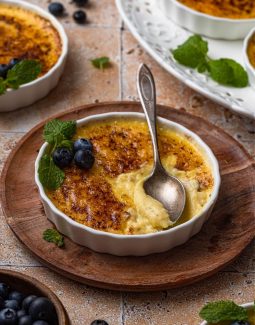Vanilla Creme Brulee is the quintessential French dessert! It’s a rich, creamy custard topped with a crackly caramel topping made from caramelized sugar. Despite the fancy French name, it is easy to make and requires only 5 ingredients!
Love classic French recipes? 🇫🇷 Then you’ll also like my recipes for Coq au Vin, Boeuf Bourguignon, Gougeres, French Onion Soup and Poulet à la Moutarde.
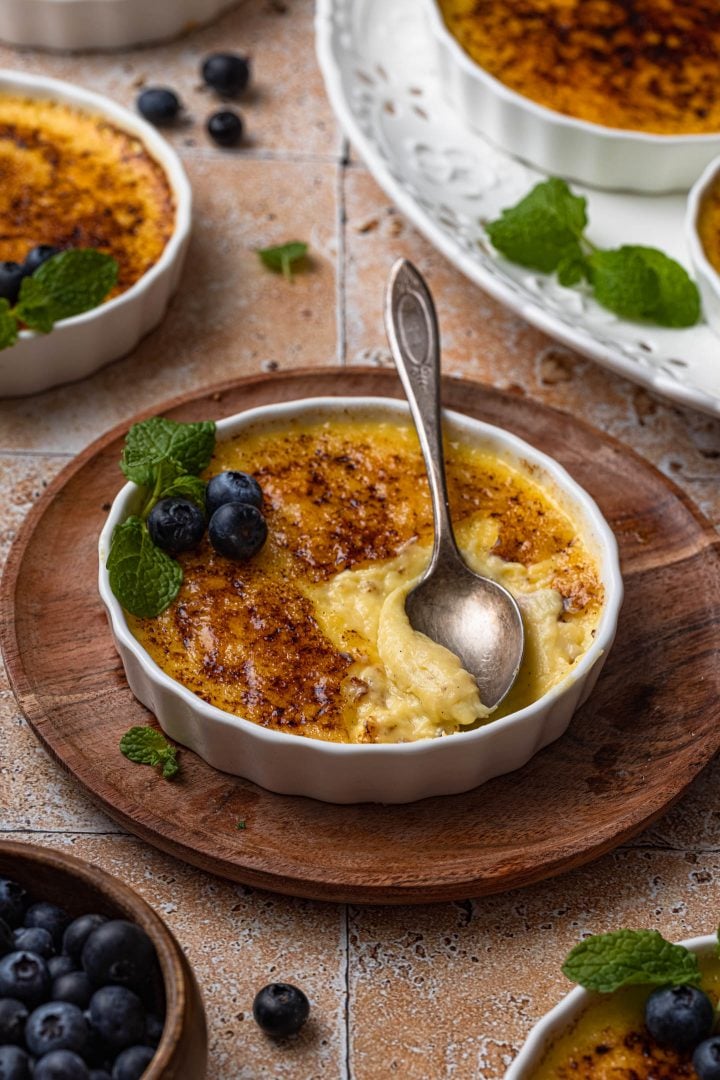
Creme Brulee is one of my favorite recipes to order when dining at a restaurant. I just can’t resist it!
But that also means that I’ve had my fair share of “meh” creme brulee. Runny, bland, brulee topping not crackly enough, different flavor twist gone wrong (I’m looking at you matcha), you name it! So I decided it was time to learn to make it homemade and I braced myself to something incredibly difficult, complicated and… well, French!
To my surprise, this was one of the easiest dessert recipes I have ever done. Yes, it requires planning ahead because the custard has to chill in the fridge for at least 4 hours. But, apart from that, making creme brulee is a walk in the park!
In a way, I’m kinda glad I didn’t learn this earlier in life, or I’d be even more overweight than I already am! 😂
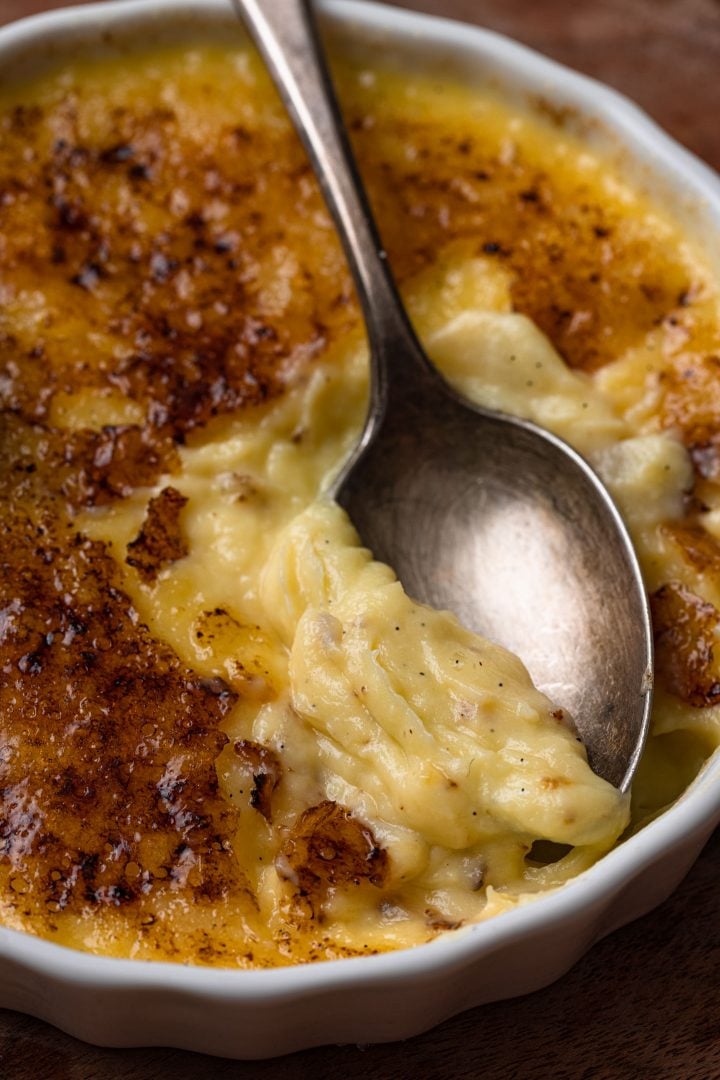
What is Creme Brulee?
Crème Brûlée (pronounced krem-boo-lay), which means “burnt cream”, is a French dessert that consists of a rich custard topped with caramelized sugar. The classic version is flavored with vanilla, but nowadays you can find lots of different creme brulee flavors, such as chocolate, lemon, matcha (🙄), and even lavender!
Earlier versions of this dessert in France had the brulee topping presented as a previously prepared caramel disc. It is only in modern versions that the sugar is burnt with a torch.
Where did it originate?
France, England and Spain all claim to be the ones that created the first version of this dessert.
The first recording of creme brulee in its French form happened in 1691, in François Massialot’s cookbook called Le Cuisinier Royal Et Bourgeo. However, since custards have been popular across Europe since the Middle Ages, it’s impossible to pinpoint the creme brulee’s roots.
The crema catalana, which is the Catalan dessert the Spanish claim inspired the creme brulee, dates back to the 14th century. It is very similar to creme brulee, but made with milk instead of cream, and flavored with orange (or lemon) zest and cinnamon. It is traditionally served on Saint Joseph’s Day.
Then there’s England’s claim, a similar custard dessert with a caramelized topping, called “Trinity Cream” or “Cambridge Burnt Cream”. It was introduced at Trinity College, in Cambridge, in 1879, and the blistered sugar topping was embossed with the college arms via a branding iron. Legend has it that it was an undergraduate that offered the recipe (from an Aberdeenshire country house) to the college cook. The cook initially turned it down but later, after the student became a fellow, started serving it. That dessert is still served at the school today!
That all being said, it wasn’t until well into the 1980s that the creme brulee gained the popularity it has today, probably after Sirio Maccioni introduced it at his New York restaurant “Le Cirque”. According to food writer Colman Andrews, it became “a symbol of that decade’s self-indulgence and the darling of the restaurant boom”.
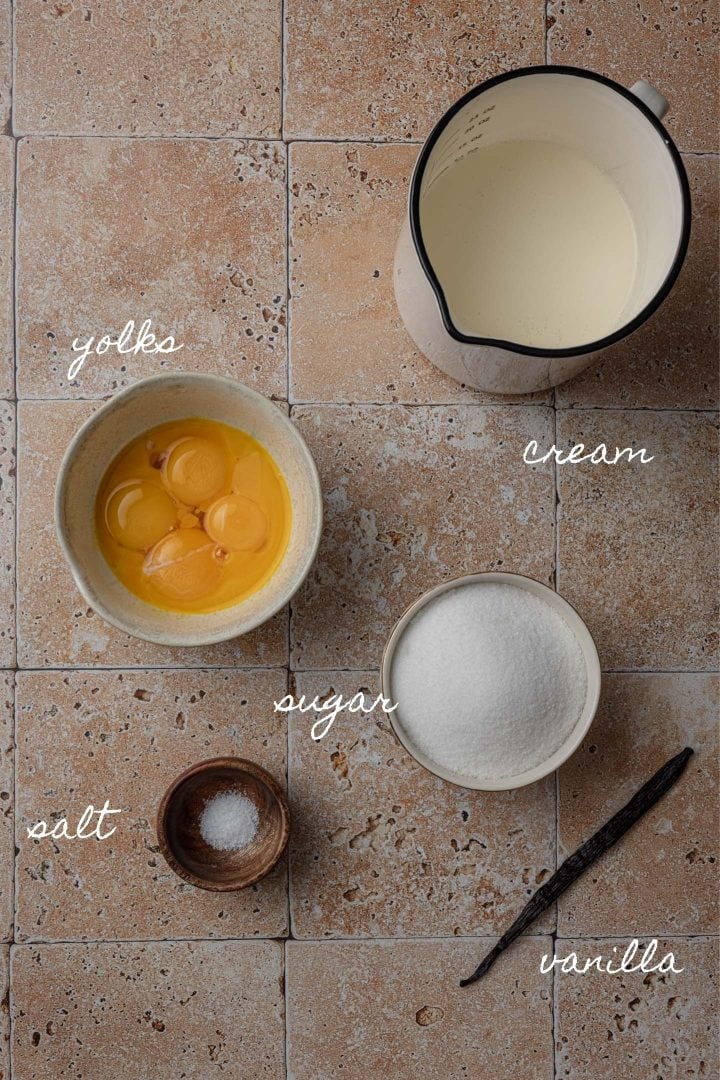
Ingredients
To make this Vanilla Creme Brulee recipe, you will need:
- Sugar – You will need white granulated sugar to make the custard and also to make the brulee topping.
- Egg Yolks – For a creamy and rich custard, we’ll use just yolks. Save the whites to make meringue or pavlova!
- Heavy Cream – I have seen recipes call for milk or half and half in addition to, or instead of, heavy cream. I imagine the custard would be lighter, but since I like my creme brulee as French as it can be (as in very creamy and flavorful), I always make mine with heavy cream.
- Vanilla – I strongly recommend you use vanilla beans to make this creme brulee recipe. If you must substitute, vanilla extract is okay but the vanilla flavor won’t be as pronounced.
- Salt – A small pinch of salt enhances flavors.
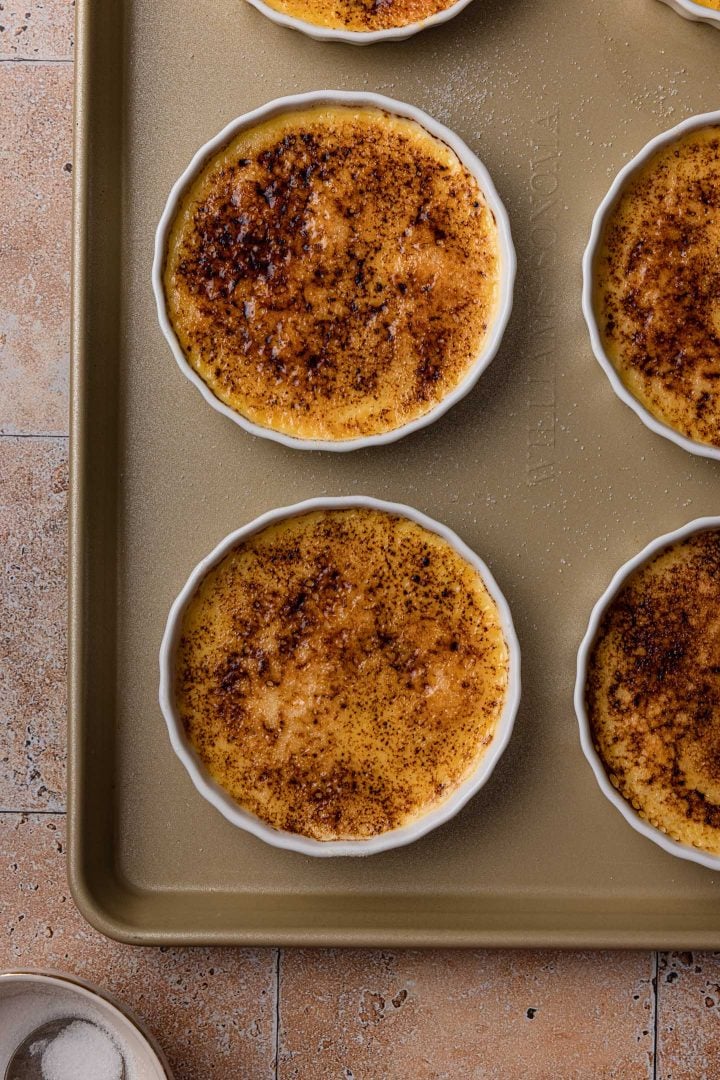
How to Make Vanilla Creme Brulee
Is it difficult to make creme brulee? No. Can it go terribly wrong? Yes, if you try to skip some steps or under/overcook it.
These are some common creme brulee problems and the reason they happen:
- Soupy or Runny Creme Brulee – Is your yolks to cream ratio correct (3 yolks per cup of liquid)? If using my recipe it is, so you, most likely, undercooked it. It also needs at least 4 hours in the fridge to finish setting.
- Grainy/Scrambled Creme Brulee – If you don’t temper the egg yolks, the eggs can scramble and you will end up with a sweet omelette instead of a custard.
- Curdled Creme Brulee – You probably overcooked it. Creme Brulee will curdle if its internal temperature goes above 175ºF. That’s why it is highly recommended to bake the custards in a water bath.
If you encountered the problem of an unset custard, you can fix it if you don’t mind the extra effort. I have not tested this method, but according to my research, it works. Just scrape off the custard into a strainer and press with a rubber spatula, into a bowl. That should leave you with a smooth custard base. Place the custard in a double boiler and slowly heat it, then transfer to ramekins and bake in a water bath in a 300ºF oven, until set.
But if you follow my recipe and tips, you will not have to fix anything as your creme brulee will come out perfect every time!
Recommended tools and equipment: saucepan, mixing bowl, whisk, ramekins, baking sheet, torch.
Here’s how I make this creme brulee recipe. As always, you will find the printable (and more complete) version of the recipe at the end of this post!
Step 1: Make the custard
- Split vanilla bean in half lengthwise and scoop the seeds out with a knife or spoon.
- Heat the heavy cream with the vanilla seeds, vanilla bean and salt. Then, turn off the heat, cover and let the mixture infuse for 5 to 10 minutes.
- Whisk the yolks and sugar in a bowl until light and creamy. That will require some arm work, unless you want to use a hand mixer.
- Add a ladleful of the hot liquid to the yolk mixture, whisking constantly, to temper the eggs. Then, add the remaining of the liquids, whisking to combine.
- Pour the mixture into six ramekins and transfer the ramekins to a rimmed baking dish.
Step 2: Bake the custard
- Fill the baking dish with boiling water so it covers the ramekins two-thirds up their sides.
- Bake for 30 to 40 minutes, or until the custards are barely set (center still a little jiggly). Internal temperature should be 170-175ºF if you prefer to check with a thermometer.
- Remove from oven and let them cool completely, then carefully cover with plastic and refrigerate for at least 4 hours or, better, overnight.
Step 3: Make the brulee topping
- Remove the creme brulee from the fridge and let it stand at room temperature for at least 30 minutes before you do the brulee topping.
- If you notice any moisture on top of the custards, gently dab it away with a paper towel.
- Sprinkle sugar on top of each custard. You can swirl the ramekins to distribute the sugar evenly, creating a thin layer.
- Using a torch, melt the sugar so it caramelizes and hardens, creating the signature crackly top.
- Let the creme brulee sit for 5 minutes before serving.
Making Creme Brulee without a Torch
For best results, a torch is highly recommended. You can get one on Amazon for as little as 15 bucks!
That being said, if you do not own one and do not want to get one, you can caramelize your creme brulee topping using your broiler. To do that, move your top rack as close to the broiler as possible, then turn the broiler on and broil the creme brulee with the sugar topping for 5 to 10 minutes, rotating them as needed so the sugar caramelizes evenly.
Olivia’s Tips
- Do not skip tempering the egg yolks! That will ensure your eggs don’t scramble. If even with tempering the yolks you find that your mixture is a little grainy, just strain it before pouring in the ramekins.
- A water bath is a must for a perfect and silky custard. It makes the custard bake more gently and evenly, keeps the custard from curdling and contributes to a smooth and creamy texture.
- Be careful when pouring the boiling water in the baking pan. You don’t want to get water in the custard as that will ruin the texture, making it soggy and unset. I like to place the baking sheet with the ramekins in the oven before pouring the water.
- When making the brulee topping, make sure you cover the whole surface of the custards with a thin layer of sugar. If you heat the exposed custard, it might curdle!
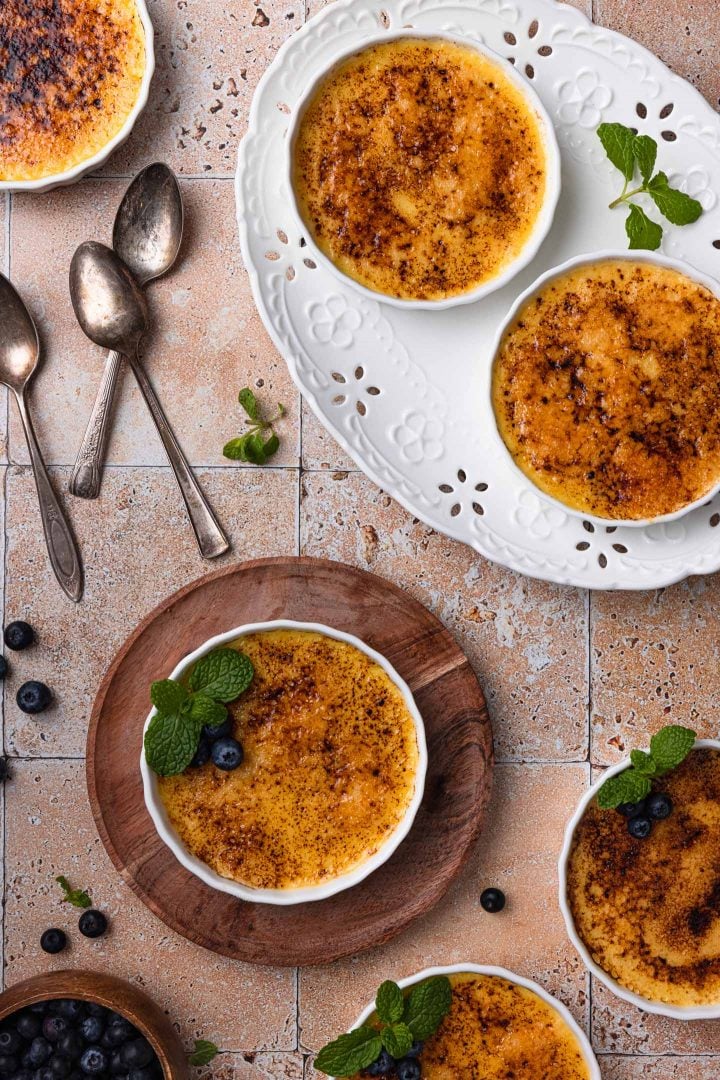
Serving Creme Brulee
Creme Brulee is traditionally served cold with the topping warm, since you are supposed to torch it and immediately serve it! However, I know some restaurants like to put the creme brulee in the freezer after torching, to quickly set the top and reduce some of the heat. You can do that or even refrigerate the ramekins for up to 30 minutes, but no more than that or the sugar crust will begin to soften.
Garnishing is optional, but if you want to embellish your creme brulee, you can decorate with fresh mint and berries!
Variations
Creme Brulee variations are endless! A quick Google search and you will find several creative recipes to try.
Here are a few suggestions:
- Chai or Earl Grey Creme Brulee – When infusing the cream with the vanilla, add a bag of chai or earl grey tea to steep in the liquid.
- Chocolate Creme Brulee – Whisk in about 4 ounces of chopped bittersweet chocolate to the hot cream, before you temper the eggs.
- Raspberry Creme Brulee – Make a raspberry (or whatever berry you like) coulis by cooking 1 pint of the berries with 1/2 cup sugar until thickened. Add a layer of the coulis to the bottom of the ramekins before adding the custard.
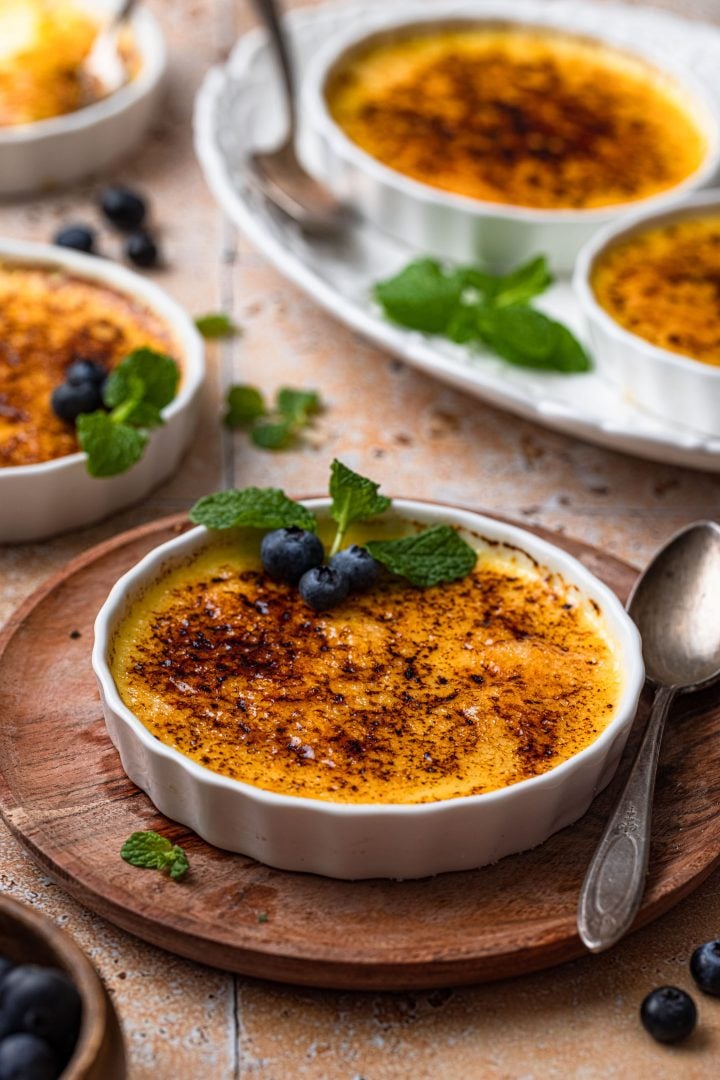
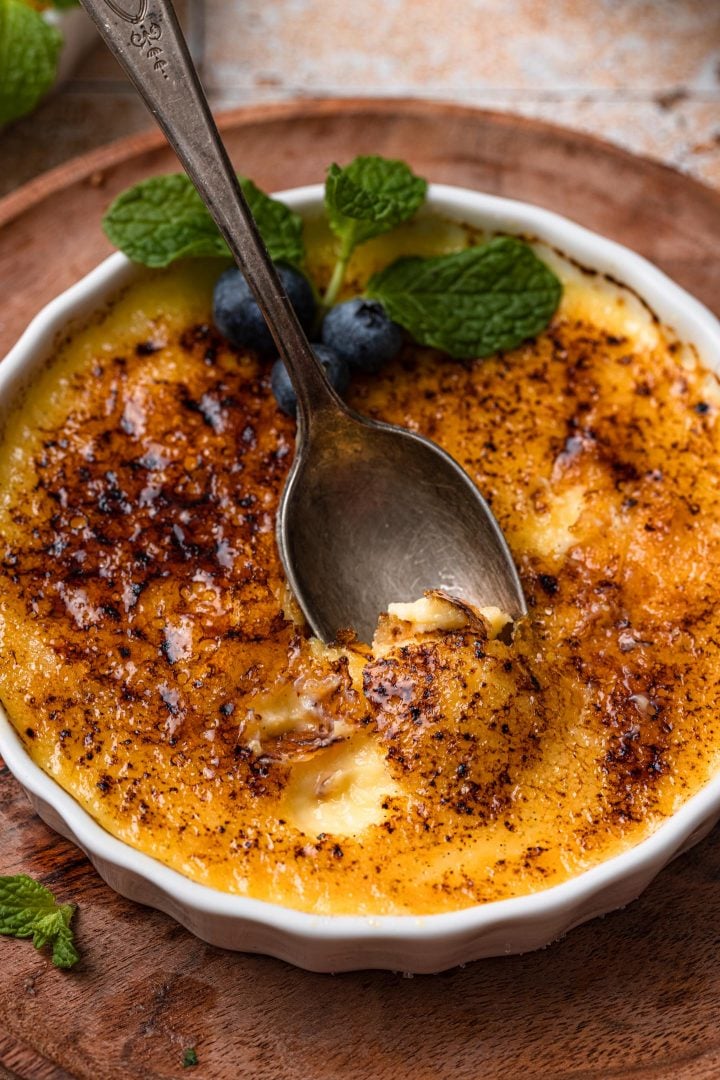
Frequently Asked Questions
Creme Brulee is traditionally made in wide, shallow ramekins. You can find them in 4-ounce, 5-ounce, and 6-ounce capacity. This recipe was tested in 5oz ramekins and makes 6 of them. If you use the smaller capacity ones, you will probably make more servings. If using a higher capacity ramekin, they might not fill to the very top.
Since the custard has to chill in the fridge to set, creme brulee is the perfect make-ahead dessert! You can make the custard up to 4 days ahead. The brulee part has to be done right before serving.
Unfortunately, creme brulee does not freeze well. Custards have a tendency to separate when frozen and thawed.
More Dessert Recipes
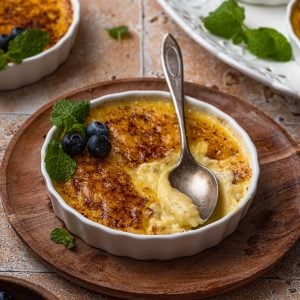
Creme Brulee
Vanilla Creme Brulee is the quintessential French dessert! It’s a rich, creamy custard topped with a crackly caramel topping made from caramelized sugar. Despite the fancy French name, it is easy to make and requires only 5 ingredients!
- 2 cups heavy cream
- 1 vanilla bean, split lengthwise and seeds scooped out
- ¼ teaspoon kosher salt
- 6 large yolks
- ¾ cup white granulated sugar, divided
Baking pan
Saucepan
5-ounce Ramekins
Kitchen Torch
Preheat oven to 325ºF with a rack in the middle.
Combine the heavy cream, vanilla bean, vanilla seeds and salt in a saucepan. Heat, over medium heat, until steaming. Then turn the heat off, cover and let it steep for 10 minutes. Discard the vanilla bean.
In a large bowl, whisk the egg yolks and ½ cup sugar until light and fluffy. Temper the eggs by adding a ladleful of the hot cream, whisking to combine. Pour the remaining infused cream and mix well.
Divide the mixture into six 5-ounce ramekins and place the ramekins in a rimmed baking sheet. Pour boiling water in the baking sheet, filling so it covers the ramekins two-thirds up their sides. Be careful to not get any water in the ramekins!
Bake for 30 to 40 minutes, or until barely set. The edges will be set but the middle will still be a little jiggly. If you want to use a thermometer, they are done when they get to 170ºF.
Remove from the oven and let them cool completely. Then, cover them loosely with plastic or foil and refrigerate for at least 4 hours, or up to 4 days.
Remove the creme brulees from the fridge and let them sit at room temperature for 30 minutes. If you notice any moisture on top of the custards, gently dab it away with a paper towel.
Sprinkle about 1 ½ teaspoons of sugar over the surface of each custard, swirling the ramekin so it's evenly distributed.
Using a kitchen torch, caramelize the sugar until it hardens. (Alternatively, you can place the custards under the broiler for about 5 minutes, rotating them often so they caramelize evenly. Let the creme brulees set for 5 minutes before serving.
Serve immediately!
- Ramekin Size: Creme Brulee is traditionally made in wide, shallow ramekins. You can find them in 4-ounce, 5-ounce, and 6-ounce capacity. This recipe was tested in 5oz ramekins and makes 6 of them. If you use the smaller capacity ones, you will probably make more servings. If using a higher capacity ramekin, they might not fill to the very top.
- Make Ahead Creme Brulee: You can make the custard up to 4 days ahead. However, the brulee topping should be done right before serving.
- Got leftovers? Depending on how long you initially had the creme brulee in the fridge to set, the leftovers will keep for up to 5 days without losing quality. However, if they already have the brulee topping, it will be soft and not crackly like they should. The creme brulee will still be delicious, though! If you simply must enjoy it as fresh, you could scrape the topping off and make it again.
Calories: 417kcal, Carbohydrates: 28g, Protein: 4g, Fat: 33g, Saturated Fat: 20g, Polyunsaturated Fat: 2g, Monounsaturated Fat: 10g, Cholesterol: 262mg, Sodium: 134mg, Potassium: 76mg, Sugar: 25g, Vitamin A: 1370IU, Vitamin C: 1mg, Calcium: 70mg, Iron: 1mg
Source link

